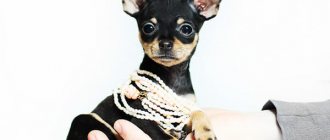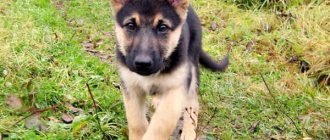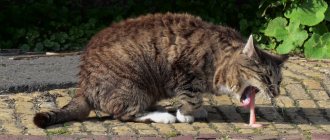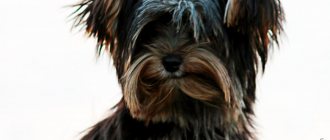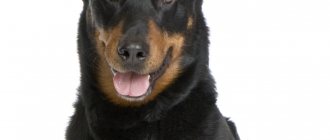Sensitive ears allow you not only to rely on the shepherd as an excellent watchman, but also to guide it from a great distance
A thick-bellied and thick-footed kitten of shepherd color with a long tail and thick fur can only be definitively classified as purebred when the German Shepherd puppy’s ears stand up.
The ears of a real German Shepherd, according to the standard, are erect, of medium size, set high, with the ends directed forward and upward, not adjacent to the skull on both sides, even when the shepherd is in motion, presses his ears or lowers them in a calm state. This “blooming” of the ears is not a fault.
When a German Shepherd's ears stand up when excited, the distance between their highest points (ear tips) should be visually equal to the width of the auricle.
When do your ears stand up?
The process is completely individual and depends on many factors. Normally, a puppy’s ears stand up from one to 6 months.
When should you sound the alarm?
If after six months the ears remain droopy, you should show your pet to a specialist or carry out the correction yourself. After 7 months, it will be difficult and almost impossible to lift them.
However, experienced German Shepherd breeders claim that action should begin as early as 4 months. If, upon reaching this age, the puppy has any problems with the ears, he needs help.
To choose a healthy shepherd from a breeder, inspect your pet's ears:
- If they are too thin, they are less likely to stand up on their own.
- Small ears are more likely to stand up without your help.
- Closely spaced ears are more likely to rise.
How to avoid incorrect development?
It is recommended for a German Shepherd to massage the ears at home. This procedure stimulates blood circulation. It is also imperative to properly prepare a diet for such a dog. Her food should be varied. It must contain the necessary vitamins and minerals.
It is also advisable to stroke the animal’s head as little as possible, otherwise a scar may form along the length of the entire ear and closely monitor its health. If necessary, take him to a veterinarian and consult with him.
Reasons why ears don't stand up
Problems with cartilage in a dog can be due to the following reasons:
- lack of calcium and phosphorus in the body;
- injury/illness in infancy;
- poor maternal nutrition during pregnancy;
- genetics, the puppy is not purebred.
How is the change of teeth related to ear cartilage?
It happens that by the age of 3 months the puppy’s ears stand up, and a month later they fall off again. This is normal and is associated with the change of baby teeth to molars. The body uses all the calcium that the puppy receives to form a new set of teeth. In this case, there is no need to worry. As soon as the change of teeth is completed, the ears will fall back into place. To be more confident, you can give the puppy food, see more details below.
Prevention
To prevent problems with raised ears in a dog, as well as to avoid drastic decisions for their development, it is worth taking preventive actions. It is important to know that at a young age the body is actively growing and requires a large supply of vitamins and nutrients. A lack of useful elements will inevitably lead to impaired development of intelligence and improper growth of the dog’s body. The schedule for vaccinations and deworming should be strictly followed. The muscle mass of the ears and the formation of cartilage tissue directly depend on the health of the German Shepherd.
Among other things, you need to maintain dog hygiene - constantly clean the ears, check for the presence of blood-sucking insects. If fleas are detected, you need to take immediate action - treat the fur with sprays and aerosols. If a tick is found, it must be removed. The dog should be shown to a veterinarian, because the insect can cause severe harm to the puppy’s fragile body. Redness, discharge, and ear injuries should not be ignored either. It is imperative to show the puppy to the veterinarian if there are any deviations in his health.
What to do?
If your dog is more than six months old and his ears are still drooping, then they will have to be rewound. Before the procedure, be sure to consult a specialist.
It is important not to tape your dog's ears until he is six months old. Too early a procedure can cause damage to the ear.
Rewind
First you need to purchase materials. What you need for rewinding:
- large foam rollers;
- white surgical plaster in a spool;
- medical glue (preferably special dog glue, sold in veterinary pharmacies);
- wooden stick for fixing ears.
When everything you need has already been purchased, proceed to the procedure. Make sure everything is sterile and wash your hands thoroughly. The dog must be calm. The procedure is as follows:
- Wipe your puppy's ears with an antiseptic.
- Take curlers. Take the center out of them, leaving only the foam base. Take a pencil and insert it into the hole with the eraser first, but not all the way. The pencil is needed for stabilization; it will then need to be removed.
- Apply medical glue to the outside of the curler. Make sure there is not too much glue so that it does not get into the ear canal.
- Place your ear in a vertical position and attach curlers to the hanging part. Leave some distance between the edge of the curler and the dog's head so as not to close the ear canal. Apply a little pressure to your ear so that the curler can secure itself.
- While holding the pencil, wrap a bandage around your puppy's ear. Do not attach the patch too tightly so as not to cause discomfort to your pet. When it's all over, put the pencil away.
- Attach a wooden stick to the back of the ear. This will secure the ears in a standing position.
- After all the steps, it will take about 5-7 minutes for the patch to attach. Distract your puppy during this time: feed him a treat or play.
The patch is worn for 10-14 days.
Alternative way
Alternative ear fixation:
- Gently feel your dog's ears for weak cartilage. When you find one, the ears will immediately straighten.
- Cut a piece of cardboard slightly larger than the problematic cartilage.
- Disinfect your puppy's ears. Take an adhesive plaster and stick it on the weak cartilage. Lubricate a piece of cardboard with medical glue. Stick it on the plaster, then secure it with the 2nd layer of plaster.
Breeders and veterinarians prefer the first method. But if you don’t like it, the right to choose remains yours.
The most gentle way
One of the methods for setting up ears is gluing. To do this, you must first identify the weak points in the auricle.
If they are located in the lower or upper part of the ear, then you cannot do without it:
- Prepare two pieces of cardboard that will be slightly larger than the weak point, cut off a piece of adhesive tape.
- Plug the dog's ear canal with cotton wool, then shave the area where you will glue the cardboard. Treat the area that had to be cut. Treat the sticky side of the patch as well - this is necessary so that when peeling it off you do not damage the sink. Wait for it to dry and stick the patch on. Press it to your ear and smooth it out.
- Next, take a piece of cardboard, grease it and the patch in the ear with Moment glue or another quick-drying glue. Holding the ear, glue the cardboard. Then secure it with a second piece of tape.
- If this procedure is required on the second ear, then repeat it in the same way.
- Keep the patch on your ears for 1-2 weeks.
After care
The most important part of ear rewinding is post-procedure care. A playful baby will try to pull off an unknown structure. Your task is to prevent this from happening. The first day after rewinding is usually the most difficult, because the dog did not have time to get used to the patch.
It happens that even after gluing the puppy’s ears fall off again. To prevent this from happening, follow these rules:
- Provide your pet with high-quality, nutritious food;
- protect the animal from injury: do not allow children to torture the dog, do not allow fights with other dogs;
- do not leave the animal in the cold for a long time.
What supplements should you give your puppy?
To stimulate ears to set, provide your puppy with a tablespoon of cottage cheese at each feeding. This will compensate for the lack of calcium. But we do not recommend using special calcium supplements, as this may lead to health problems in the future. But you shouldn’t give up vitamin supplements for dogs. This will strengthen the growing body and will not cause any harm. To make your puppy move his ears more, give him something to chew on from time to time.
As it should be according to the standard
A German Shepherd's ears should stand upright with the tips pointed upward.
If a German Shepherd's ears do not stand up, then the main task of the dog breeder is to notice this problem in time, find the cause and solution. After all, the health of a dog depends entirely on its owner.
Ear hygiene and treatment of otitis media
The auricle and external auditory canal of the German Shepherd are examined 2 times a week for redness and discharge. To remove common light dirt, use lotions for cleaning dog ears, for example: Auricap, Otifree; Hartz Ear Cleaner for dogs and cats; VetExpert Otiflush.
The lotion is applied to a gauze swab or cosmetic cotton pad and gently wiped over the inner surface of the ear. There is no need to reach too deeply with your fingers or foreign objects into the dog’s ear canal, as this can injure the delicate skin. Using human ear sticks is also not recommended because a small piece of cotton can slip off and remain in the ear canal.
The most common ear disease is otitis media, which can be caused by a bacterial and/or fungal infection or a microscopic ear mite (otodecosis). Signs of otitis media include excessive discharge from the ear canal, unpleasant odor, redness, itching and pain.
Watery and yellow-brown discharge is usually found with a fungal infection, and black, charcoal-like discharge is usually found with otodecosis. The shepherd dog experiences obvious discomfort, shakes its head, rubs and scratches its ears with its paws, and with severe otitis media, holds its head to one side, tilting towards the sore ear. Otitis in puppies leads to delayed ear placement.
Prolonged chronic otitis media can be caused by keeping the dog in damp and cold conditions, as well as by poor ear hygiene. Fans of swimming and diving in natural bodies of water are extremely prone to such problems.
For successful treatment of otitis media, the intervention of a veterinary specialist is necessary to determine the nature of the pathogen. For mixed fungal and bacterial infections, the following ear drops can be recommended: Otibiovin; Otoxolan; Otospectrine. Surolan; VetExpert Otihelp. When mites are detected, use aversectin ointment, amitrazine, anandin, Bars drops, or complex preparations such as Otoferonol Gold or Oridermyl.
It should be remembered that otitis media are prone to relapses, and therefore require the most serious approach to treatment.
Views: 2,235
Before you start reeling
To get your ears fitted, it is best to contact an experienced specialist. But if you are confident in yourself and your abilities, you can do this procedure yourself. Below we provide some important tips to help you.
Firstly, do not rush this process; it is better to wait six months, when the change of teeth ends. If you rush, you will only harm the German Shepherd and in the worst case, the ears may not stand up.
Secondly, do not overuse calcium. Fifty grams of yogurt or kefir is much better than nutritional supplements. The excess will be deposited in the dog's bones and lead to orthopedic problems in the future.
Thirdly, monitor the implementation of the schedule of vaccinations and deworming. The health of the puppy is directly related to the muscle strength of the ears.
Fifthly, do not forget about special toys and bones. By gnawing on them, the pet strengthens the muscles of the ears.
Sixth, do not allow other dogs to drag your pet by the ears to avoid injury.
"Anatomy" of a German ear
When a puppy is born, its ears are small, soft, and close to the head. The auricle is cartilage; in a newly born pet it is tender and pliable. Gradually, as the German Shepherd grows, the ears stand up, increase in size, become stronger, and the cartilaginous plates become elastic. There are no blood vessels inside them. On both sides of the cartilage is the perichondrium, a connective tissue that ensures its growth and development. It is literally permeated with small capillaries and vessels. Thanks to blood, the necessary substances enter the cartilage tissue, elastin and collagen are produced, as a result the auricle becomes strong and elastic.
To improve blood supply to the perichondrium, the dog is provided with adequate nutrition and physical activity.



